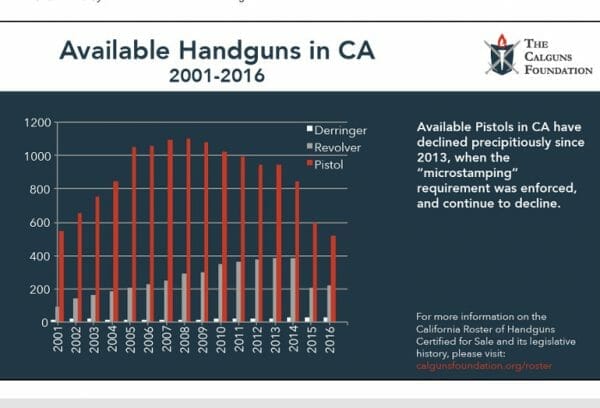PA Bill Number: SB1125
Title: Providing for welcoming schools.
Description: An Act amending the act of March 10, 1949 (P.L.30, No.14), known as the Public School Code of 1949, providing for welcoming schools.
Last Action: Referred to Education
Last Action Date: Dec 22, 2025
California Supreme Court Rules Law Requiring the Impossible is Constitutional :: 07/03/2018
Arizona -(Ammoland.com)- In 2007, California passed a law requiring all new semi-automatic handgun models have dual stamp micro-stamping incorporated in their design. Because of legal challenges, the law did not go into effect until 2013. In 2013, California AG Kamala Harris insisted on enforcing the law. No new handgun models have been added to the California handgun roster since that time.

Manufacturers have stated that dual microstamping, as required by the California law, is technologically and commercially impossible. The State appeals court ruling was appealed to the California Supreme Court, on the grounds that the law cannot require an impossibility.
On June 28, 2018, the California Supreme Court ruled the State legislature can require impossible things, if that was the legislature's intent. From sfchronicle.com:
Gun manufacturers must do their best to comply with a California law requiring new models of semiautomatic handguns to imprint their bullets with identifying micro stamps so police can trace them, the state Supreme Court ruled Thursday, rejecting the companies’ arguments that the law should be overturned because compliance is technologically impossible.
A gun-control advocate said the ruling preserves safety regulations that encourage industries to develop new technologies. A gun organization’s lawyer said the state is headed for a “slow-motion handgun ban.”
The gun law, passed in 2007, is supported by police organizations that say the stamps would help officers to determine the source of bullets found at crime scenes. It requires that new brands of semiautomatic pistols introduced for retail sale in California carry markings in two places that would imprint the gun’s model and serial number on each cartridge as it is fired.
A federal legal challenge to the law on Second Amendment grounds was filed in June of 2013. The district court upheld the law. An appeal was filed in the Ninth Circuit. The oral arguments were heard on March 16th, 2017, over a year ago, by a three judge panel. Here is a video summation of the oral arguments done by CalGuns.
The Ninth Circuit still has not ruled, over a year later. If the the three judge panel in the Ninth rules for the Second Amendment, I expect a judge on the Ninth will demand a vote for an en banc ruling by the entire Ninth Circuit. That has been the pattern for recent Second Amendment cases in the Ninth Circuit.
The Ninth Circuit, en banc, has been ideologically hostile to the Second Amendment.
A new Supreme Court justice, appointed by President Donald Trump to replace retiring Justice Kennedy, should be on the Supreme Court by the time the Court would be called to hear an appeal from the Ninth Circuit on this case.
That might, or might not make the difference in whether or not the Supreme Court would decide to hear an appeal of the case.
The Supreme Court has been able to pick and choose what cases it will hear since 1891. In 1891, the legislature gave the power to refuse cases to the Supreme Court, in order to reduce the Courts workload. Instead of being heard by the Supreme Court, most cases are heard by the appellate courts.
The Ninth Circuit has become the Circuit with the highest percentage of decisions overturned by the Supreme Court.
©2018 by Dean Weingarten: Permission to share is granted when this notice is included.
About Dean Weingarten:
Dean Weingarten has been a peace officer, a military officer, was on the University of Wisconsin Pistol Team for four years, and was first certified to teach firearms safety in 1973. He taught the Arizona concealed carry course for fifteen years until the goal of constitutional carry was attained. He has degrees in meteorology and mining engineering, and recently retired from the Department of Defense after a 30 year career in Army Research, Development, Testing, and Evaluation.



